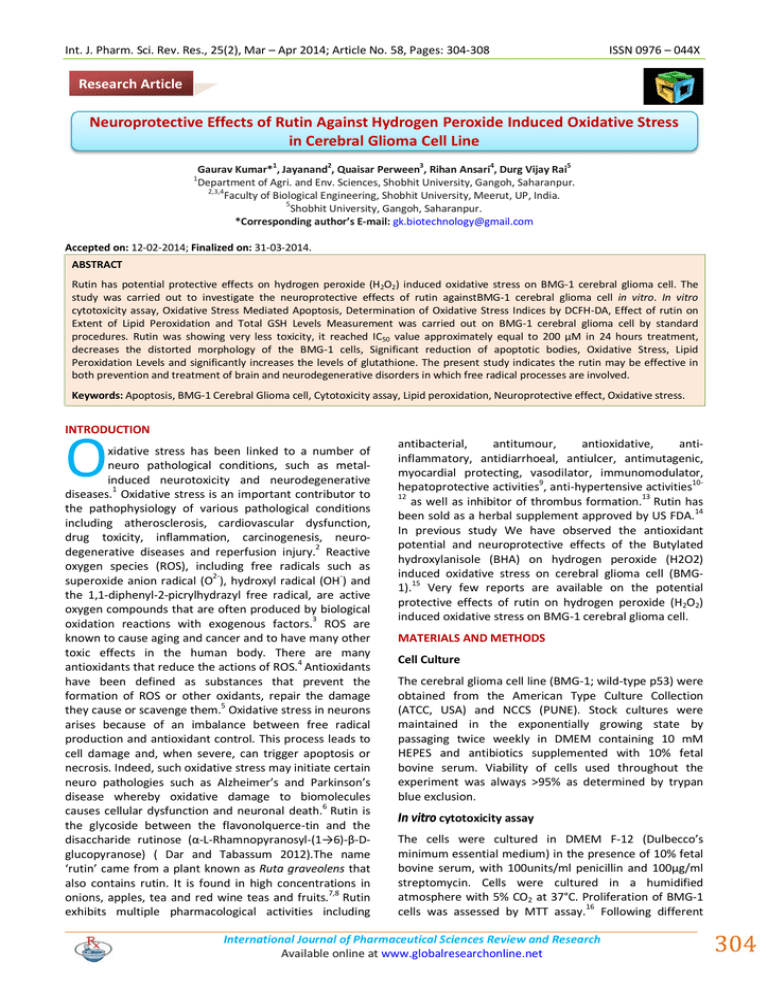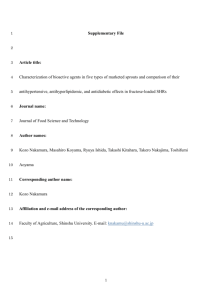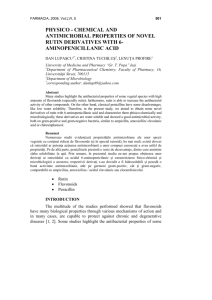Document 13309710
advertisement

Int. J. Pharm. Sci. Rev. Res., 25(2), Mar – Apr 2014; Article No. 58, Pages: 304-308 ISSN 0976 – 044X Research Article Neuroprotective Effects of Rutin Against Hydrogen Peroxide Induced Oxidative Stress in Cerebral Glioma Cell Line 1 1 2 3 4 5 Gaurav Kumar* , Jayanand , Quaisar Perween , Rihan Ansari , Durg Vijay Rai Department of Agri. and Env. Sciences, Shobhit University, Gangoh, Saharanpur. 2,3,4 Faculty of Biological Engineering, Shobhit University, Meerut, UP, India. 5 Shobhit University, Gangoh, Saharanpur. *Corresponding author’s E-mail: gk.biotechnology@gmail.com Accepted on: 12-02-2014; Finalized on: 31-03-2014. ABSTRACT Rutin has potential protective effects on hydrogen peroxide (H2O2) induced oxidative stress on BMG-1 cerebral glioma cell. The study was carried out to investigate the neuroprotective effects of rutin againstBMG-1 cerebral glioma cell in vitro. In vitro cytotoxicity assay, Oxidative Stress Mediated Apoptosis, Determination of Oxidative Stress Indices by DCFH-DA, Effect of rutin on Extent of Lipid Peroxidation and Total GSH Levels Measurement was carried out on BMG-1 cerebral glioma cell by standard procedures. Rutin was showing very less toxicity, it reached IC50 value approximately equal to 200 µM in 24 hours treatment, decreases the distorted morphology of the BMG-1 cells, Significant reduction of apoptotic bodies, Oxidative Stress, Lipid Peroxidation Levels and significantly increases the levels of glutathione. The present study indicates the rutin may be effective in both prevention and treatment of brain and neurodegenerative disorders in which free radical processes are involved. Keywords: Apoptosis, BMG-1 Cerebral Glioma cell, Cytotoxicity assay, Lipid peroxidation, Neuroprotective effect, Oxidative stress. INTRODUCTION O xidative stress has been linked to a number of neuro pathological conditions, such as metalinduced neurotoxicity and neurodegenerative diseases.1 Oxidative stress is an important contributor to the pathophysiology of various pathological conditions including atherosclerosis, cardiovascular dysfunction, drug toxicity, inflammation, carcinogenesis, neurodegenerative diseases and reperfusion injury.2 Reactive oxygen species (ROS), including free radicals such as superoxide anion radical (O2-), hydroxyl radical (OH-) and the 1,1-diphenyl-2-picrylhydrazyl free radical, are active oxygen compounds that are often produced by biological 3 oxidation reactions with exogenous factors. ROS are known to cause aging and cancer and to have many other toxic effects in the human body. There are many antioxidants that reduce the actions of ROS.4 Antioxidants have been defined as substances that prevent the formation of ROS or other oxidants, repair the damage 5 they cause or scavenge them. Oxidative stress in neurons arises because of an imbalance between free radical production and antioxidant control. This process leads to cell damage and, when severe, can trigger apoptosis or necrosis. Indeed, such oxidative stress may initiate certain neuro pathologies such as Alzheimer’s and Parkinson’s disease whereby oxidative damage to biomolecules causes cellular dysfunction and neuronal death.6 Rutin is the glycoside between the flavonolquerce-tin and the disaccharide rutinose (α-L-Rhamnopyranosyl-(1→6)-β-Dglucopyranose) ( Dar and Tabassum 2012).The name ‘rutin’ came from a plant known as Ruta graveolens that also contains rutin. It is found in high concentrations in onions, apples, tea and red wine teas and fruits.7,8 Rutin exhibits multiple pharmacological activities including antibacterial, antitumour, antioxidative, antiinflammatory, antidiarrhoeal, antiulcer, antimutagenic, myocardial protecting, vasodilator, immunomodulator, hepatoprotective activities9, anti-hypertensive activities1012 as well as inhibitor of thrombus formation.13 Rutin has been sold as a herbal supplement approved by US FDA.14 In previous study We have observed the antioxidant potential and neuroprotective effects of the Butylated hydroxylanisole (BHA) on hydrogen peroxide (H2O2) induced oxidative stress on cerebral glioma cell (BMG1).15 Very few reports are available on the potential protective effects of rutin on hydrogen peroxide (H2O2) induced oxidative stress on BMG-1 cerebral glioma cell. MATERIALS AND METHODS Cell Culture The cerebral glioma cell line (BMG-1; wild-type p53) were obtained from the American Type Culture Collection (ATCC, USA) and NCCS (PUNE). Stock cultures were maintained in the exponentially growing state by passaging twice weekly in DMEM containing 10 mM HEPES and antibiotics supplemented with 10% fetal bovine serum. Viability of cells used throughout the experiment was always >95% as determined by trypan blue exclusion. In vitro cytotoxicity assay The cells were cultured in DMEM F-12 (Dulbecco’s minimum essential medium) in the presence of 10% fetal bovine serum, with 100units/ml penicillin and 100µg/ml streptomycin. Cells were cultured in a humidified atmosphere with 5% CO2 at 37°C. Proliferation of BMG-1 cells was assessed by MTT assay.16 Following different International Journal of Pharmaceutical Sciences Review and Research Available online at www.globalresearchonline.net 304 Int. J. Pharm. Sci. Rev. Res., 25(2), Mar – Apr 2014; Article No. 58, Pages: 304-308 treatments and time points, sub-confluent monolayer culture of cerebral glioma cell line were trypsinized and cells counted with the help of hemocytometer. Cells were plated in 96-well plate 100 µL in each well with the help of multichannel pipette. After 24h of cells incubation, the medium was replaced with 100 µL medium containing different concentration of cytotoxic drug (rutin) ranging from 2nM to 20 mM and incubated for 24 h. At the end of treatment, media from control and extract -treated cells was discarded and 20 µL of MTT (0.5 mg/ml Phosphate Buffered Saline) was added to each well. Cells were then incubated for 2 h at 37°C in CO2 incubator. MTT was then discarded and the colored crystals of produced formazan were dissolved by adding 100 µL of DMSO. Absorbance of the purple blue formazan dye was measured using an ELISA reader (BIORAD) at 570 nm. Optical density of each sample was compared with control optical density and graphs were plotted. Similarly, reading at different time interval i.e. after 24hrs, 48hrs and 72 hours were measured. Oxidative Stress Mediated Apoptosis For Fluorescence based quantification of apoptosis, fresh media were plated in 6-well plate 2ml in each well with the help of pipette and Add 70 µL cell suspension (seed 5000 cells) in each well. After overnight incubation the old media were removed from each well and then washed with PBS buffer and again incubated for 10 minutes. After incubation buffer is replaced with 2 mL fresh media for the control and 1990 mL media + 10 µL H2O2 (500µM) for control plus H2O2 well. Similarly, 1000 µLrutin (100µM) + 10 µL H2O2 (500µM) + 990 µl media is added to next well and 100 µLrutin (10µM) + 10 µL H2O2 (500µM) + 1890 µl media were also added to another well and incubated for 4 hrs. After incubation the media were removed and washed 2 times by PBS buffer for detection of morphological changes of cells induced by H2O2. For fluorescence based quantification of apoptosis the cells were fixed by addition of 4 % (500 µL) formaldehyde and kept at room temperature. After 30 minutes formaldehyde was removed and 500 µL Hoechst strain is added in each wells and then washed 2 times by PBS buffer followed by 10 minutes of incubation, then micrograph were taken with the help of fluorescent microscope. Determination of Oxidative Stress Indices by DCFH-DA The cellular ROS (reactive oxygen species) accumulation was measured with the help of fluorescent probe DCFHDA (2, 7- dichloro dihydrofluorescein diacetate).17 DCFHDA is a nonfluorescent compound, and it can be enzymatically converted to highly fluorescent compound, DCF, in the presence of ROS. After exposure to 500 µM hydrogen peroxide, with or without rutin, the cells 6 (10 /ml) were incubated in 2ml of 140 mM NaCl, 5 mM KCl, 1 mM MgCl2, 5.6 mM glucose, 1.5 mM CaCl2, and 20 mM HEPES-Na, pH 7.4, and allowed to take up 5µM DCFH-DA at 37°C for 20 min, in an atmosphere of 95% air and 5% CO2. Then the cells from well were resuspended ISSN 0976 – 044X in cell lysis buffer and after loading, the fluorescence intensity (relative fluorescence unit) was measured at 485 nm excitation and 530 nm emission every 30 min for 3 h, using the 7620Microplate Fluorometer. Effect of Rutin on Extent of Lipid Peroxidation Endogenous lipid peroxidation was determined by the measurement of thiobarbituric acid reactive substances (TBARS).The extent of lipid peroxidation was determined by measuring thiobarbituric acid reactive substances 18 (TBARS) as described by Ide and Lau, 1997. At the end of the treatment of 500 µM hydrogen peroxide the cells were washed with twice with PBS and removed by scrapping in PBS, followed by low speed centrifugation. The cell pellets were resuspended in PBS. The cell suspension was mixed with twice of its volume of TBARS reagent (15% Trichloroacetic acid, 0.375% thiobarbituric acid, and 0.25N HCl), and heated for 15 minutes at 100°C. After centrifugation, the absorbance of the supernatent was measured at 532nm and concentration of TBARS is calculated. Total GSH Levels Measurement Reduced glutathione was estimated according to the method described by Ellman et al, 1959.19 One milliliter of supernatant was precipitated with 1 ml of 4% sulphosalicylic acid and cold-digested for 1 hr at 4°C. The samples were then centrifuged at 1200xg for 15 minutes at 4°C. To 1 ml of the supernatant obtained, 2.7 ml of phosphate buffer (0.1 mmol/l, pH 8) and 0.2 ml of 5, 5’ dithio-bis (2-nitrobenzoic acid) was added. The yellow colour the developed was measured at 412 nm using Perkin Elmer Lambda 20 spectrophotometer. Results were calculated using the molar extinction coefficient of the chromophore (1.36 X 104(mol/l)-1 cm-1) RESULTS AND DISCUSSION In vitro Cytotoxicity Assay It is observed in the studies that the treatment of rutin is showing very less toxicity, it reached IC50 value approximately equal to 200 µM in 24 hr treatment routine. The drug is showing same kind of trend while cells were continuously treated for longer duration of time (figure 1). It is not even showing cytotoxicity to 100% even at concentrations as high as 20 mM. Morphological changes Induced by H2O2 It is evident from the scanning micrograph (figure 2) of the cells treated with hydrogen peroxide with rutin, that rutin decreases the distorted morphology of the BMG-1 cells. In control the cells were growing in groups with normal cell size, while in case of control with hydrogen peroxide the cells are smaller in size and showing bubbly outgrowth on the surface of the cells. The same is reduced in 100µM and 10µM in concentration dependent mannner. International Journal of Pharmaceutical Sciences Review and Research Available online at www.globalresearchonline.net 305 Int. J. Pharm. Sci. Rev. Res., 25(2), Mar – Apr 2014; Article No. 58, Pages: 304-308 ISSN 0976 – 044X While in case of control cells with hydrogen peroxide shows nuclei fluorescence much brighter than normal suggestive of nuclei breakage and formation of apoptotic bodies shown by arrows in fluorescence micrograph. This formation of apoptotic bodies is significantly reduced in 100µM and 10µM rutin respectively as well as Figure 4 illustrate the fluorescence based quantification of apoptosis. Figure 1: Cytotoxicity Assay. Concentration verses Cytotoxicity graph of 24 hr, 48 hr and 72 hr reading for IC50 Value. Control Control + H2O2 (500 µM) Control Rutin (10 µM) + H2O2 (500 µM) Control + H2O2 (500 µM) Rutin (100 µM) + H2O2 (500 µM) Rutin (10 µM) + H2O2 (500 µM) Figure 3: Immuno fluorescence micrograph of the BMG-1 cells with treatment of hydrogen peroxide and drug is shown here. Rutin (100 µM) + H2O2 (500 µM) Figure 2: Morphological changes Induced by H2O2. Images of cells survival and effect of drugs on different concentration Fluorescence based Quantification of Apoptosis Immuno fluorescence micrograph of the BMG-1 cells (Figure 3) with treatment of hydrogen peroxide and drug is shown here. In control cells the nuclei of cells is showing intact DNA which shows normal fluorescence. Figure 4: Fluorescence based Quantification of Apoptosis International Journal of Pharmaceutical Sciences Review and Research Available online at www.globalresearchonline.net 306 Int. J. Pharm. Sci. Rev. Res., 25(2), Mar – Apr 2014; Article No. 58, Pages: 304-308 DCFH-DA based measure of Oxidative Stress Figure 5 represents the quantitative bar graphs of cells with observed levels of oxidative stress in cells in various treatments. This shows that control cells is having very less uptake or very less conversion of non-fluorescent probe into fluorescent one. While highest reading in control with hydrogen peroxide indicate the highest level of oxidative stress generated in cells. While in rutin treated cells, its shows rutin significantly reduces the oxidative stress levels in concentration dependent manner. ISSN 0976 – 044X significantly increases the levels of glutathione levels in concentration dependent manner. Figure 7: Quantification of Total Reduced GSH Levels. Quantitative bar graph of levels of reduced glutathione levels in control and treated cells. CONCLUSION Figure 5: DCFH-DA based measure of Oxidative Stress Quantitative bar graphs of cells with observed levels of oxidative stress in cells in various treatments. Quantification of Lipid Peroxidation Levels Figure 6 shows the quantitative bar graph showing lipid peroxidation in control and in treated cells. Rutin decreases the lipid peroxidation levels in concentration dependent manner. We have observed the antioxidant potential of the rutin. Administration of rutin has been shown to have remarkable effects on tissue thiol status, increasing intracellular GSH levels, probably by reducing extracellular cystine to cysteine, a natural metabolic antioxidant substance, has been shown in numerous types of neurological disorders to potentially be effective in both prevention and treatment of free radical mediated brain and neurodegenerative disorders. Various analogues of this molecule could be formed and checked for their activity as antioxidant reducing drugs which could be very useful in therapies of these kinds of disorders. Acknowledgement: Authors thank Dr. A. K. Mishra Scientist-G, Division of cyclotron and Radiopharmaceutical sciences INMAS, DRDO, Ministry of Defense, New Delhi, for providing necessary facilities for conducting the present work and also thankful to Dr. Puja Panwar, Scientists-D, Division of cyclotron and Radiopharmaceutical sciences, INMAS, DRDO, Ministry of Defense, New Delhi for scientific and technical help and encouragement during work. REFERENCES Figure 6: Quantification of Lipid Peroxidation Levels. Quantitative bar graph showing lipid peroxidation in control and in treated cells. Quantification of Total Reduced GSH Levels The quantitative bar graph of reduced glutathione levels in control and treated cells is illustrated by Figure 7. In control cells the levels are depleted when treated with hydrogen peroxide but after treatment of rutin 1. Aschner M, Syversen T, Souza DO, Rocha JB, Farina M, Involvement of glutamate and reactive oxygen species in methylmercury neurotoxicity, Braz. J. Med. Biol. Res, 40, 2007, 285–291. 2. Aruoma OI, Free, radicals, oxidative trace and antioxidants in human health and diseases, J Am Oil Chemist's Soc., 75, 1998, 199–212. 3. Cerutti PA, Oxidant stress and carcinogenesis, Eur J Clin Invest., 21(1), 1991, 1–5. 4. Jung CH, Seog HM, Choi IW, Park MW, Cho HY, Antioxidant properties of various solvent extracts from wild ginseng leaves, Food SciTechnol-LEB, 39(3), 2006, 266–274. International Journal of Pharmaceutical Sciences Review and Research Available online at www.globalresearchonline.net 307 Int. J. Pharm. Sci. Rev. Res., 25(2), Mar – Apr 2014; Article No. 58, Pages: 304-308 5. Halliwell B. Antioxidant characterization: Methodology and mechanism, Biochem Pharmacol, 49(10), 1995, 1341–1348. 6. Halliwell B, Oxidative stress and neurodegeneration: where are we now, Journal of Neurochemistry, 97(6), 2006, 1634– 1658. 7. Jasuja R, Passam FH, Kennedy DR, Kim SH, Hessem LV, Lin L, Bowley SR, Joshi SS, Dilks JR, Furie B, Furie BC, Flaumenhaft R, Protein disulfide isomerase inhibitors constitute a new class of antithrombotic agents, Journal of Clinical Investigation, 122(6), 2012, 2104–2113. 8. 9. 10. 11. Hertog MG, PC Hollman, MB Katan, D Kromhout, Intake of potentially anti carcinogenic flavonoids and their determinants in adults in The Netherlands, Nutr. Cancer, 20, 1993, 21–29. Janbaz KH, SA Saeed, AH Gilani, Protective effect of rutin on paracetamol- and CCl4-induced hepatotoxicity in rodents, Fitoterapia, 73, 2002, 557–563. Matsubara Y, Kumamoto H, Iizuka Y, Murakami T, Okamoto K, Miyake H, Yokoi K Structure and hypotensive effect of flavonoid glycosides in Citrus unshiupeelings, AgricBiolChem, 49, 1985, 909-914. Afanas'ev IB, Dcrozhko AI, Brodskii AV, Kostyuk VA, Potapovitch AI Chelating and free radical scavenging mechanisms of inhibitory action of rutin and quercetin in lipid peroxidation, BiochemPharmacol, 38, 1989, 17631769. ISSN 0976 – 044X 12. Afanas'eva IB, Ostrakhovitch EA, Mikhal'chik EV, Ibragimova GA, Korkina LG, Enhancement of antioxidant and anti-inflammatory activities of bioflavonoid rutin by complexation with transition metals, BiochemPharmacol, 61, 2001, 677-684. 13. Mohammad Arif Dar, Nahida Tabassum, Rutin- potent natural thrombolytic agent, International Current Pharmaceutical Journal, 1(12), 2012, 431-435. 14. Hart A, Scientists study the health benefits of a flavonoid named rutin, 2012. Available at: http://www.examiner.com/ 15. Rihan Ansari, Quaisar perween, Gaurav Kumar, Jayanand, Durg Vijay Rai, Effect Of Butylated Hydroxyanisole On Hydrogen Peroxide Induced Oxidative Stress On Cerebral Glioma Cell Line, Asian J Pharm Clin Res, 7(1), 2014. 16. Alley MC, DA Scudiero, A Monks, ML Hursey, MJ Czerwinski, DL Fin, Feasibility of drug screening with panels of human tumor cell lines using a microculture tetrazolium assay, Cancer Research, 48(3), 1988, 589–601. 17. Wan CP, Myung E, Lau BHS, An automated microfluorometric assay for monitoring oxidative burst activity of phagocytes, J. Immunol.Methods, 159, 1993, 131–138. 18. Ide N, Lau BHS, Garlic compounds protect vascular endothelialcells from oxidized low density lipoproteininduced injury, J. Pharm. Pharmacol., 49, 1997, 908–911. 19. Ellman GL, “Tissue sulfhydryl groups,” Archives of Biochemistry and Biophysics, 82, 1959, 48670–48677. Source of Support: Nil, Conflict of Interest: None. Corresponding Author’s Biography: Mr. Gaurav Kumar Mr. Gaurav Kumar is currently working as Asst. Professor at School of Agriculture and Environmental Sciences, Shobhit University, Gangoh, Saharanpur with 6 years of experience. He has completed his B.Tech. & M.Tech degree in Biotechnology from Shobhit University, Meerut, UP. He has received DSTINSPIRE Fellowship from Govt. of India. He coordinated multiple workshops and conferences at Shobhit University, also guiding under graduate and post graduate Biotech students. International Journal of Pharmaceutical Sciences Review and Research Available online at www.globalresearchonline.net 308




